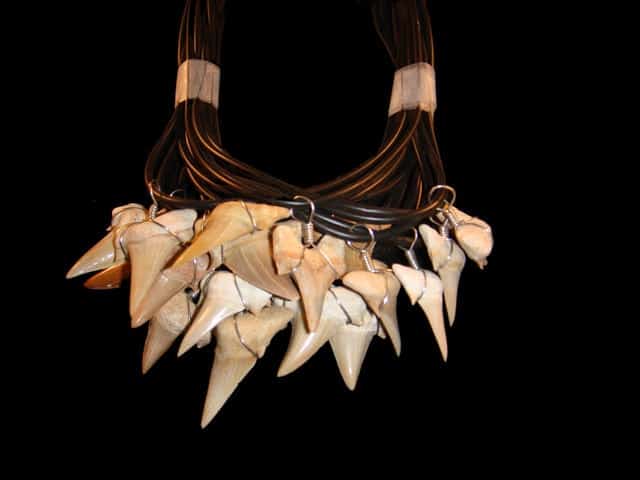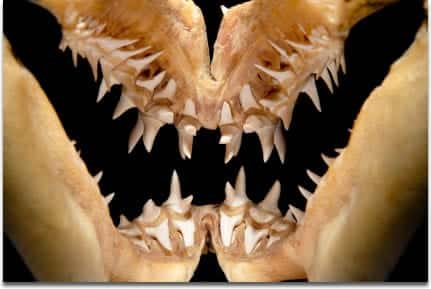Sharp, pointy, scary and hundreds of them!
When you think of sharks, first you start hearing the ominous Jaws music, then you think about those teeth. Everyone knows sharks have super scary, sharp teeth. Lots and lots of super scary, sharp teeth. So many rows. But does anyone know the real purpose for so many teeth? Maybe if you’re a Shark Week addict.
Rows of Teeth
We’ve all seen shark teeth necklaces/ornaments in gift shops lining our favorite ocean beach or at our favorite aquarium. Ever wonder how these places can get so many real shark teeth without hearing about massive shark fatalities? It’s actually quite simple. Sharks shed their teeth.

Shark teeth are not imbedded in a socket in the jaw like our teeth. Their teeth grow in from the gum tissue and fall out often. This is both a defense mechanism and a health benefit. Sharks don’t suffer from cavities or dental infections like humans or other animals. If a tooth is starting to have problems, the natural defenses of the sharks body will simply boot the tooth. If a shark’s prey manages to struggle or fight back, instead of doing damage to the jaw by pulling out a tooth, the tooth simply comes out. When the tooth is lost, a new one slides into place. That is where the multiple rows of teeth come into play.

Only the front row of teeth on the upper and lower jaw are functional for sharks. The rest lay and wait. Literally, they lay against the row behind it all the way back to the gum tissue waiting to be pushed forward when the tooth in the front is removed. In taxonomy (the science of defining groups of biological organisms), shark teeth are counted in rows and series. Rows are indicated as going along the jaw while series move from front to back. So if a tooth in the front row of a series is lost, the tooth in the second row of that same series moves forward to take its place, and the tooth in the third row moves up one, and so on. Basically, the shark’s teeth move as if on a conveyor belt or much like the cards of a rolodex. A shark can have several rows at any given time, and it’s never a set amount. Not all bull sharks have exactly 5 rows of teeth all the time, it varies on age, health, diet and many other conditions. Some sharks can lose up to 30,000 teeth in its lifetime. The teeth of plankton-feeders such as the basking shark are small and non-functional for eating.
Shark Mouth Anatomy
Any Shark Week enthusiast will tell you a shark’s skeleton is not made of bone, but made of cartilage and connective tissues. Their jaws are not attached to the cranium, it sits just under the skull with a small cartilage hinge-like-piece between the two structures. In most animals, only the lower jaw can move freely but the upper jaw is attached to the skull. In sharks, the upper jaw can detach when the shark attacks. The hinge-like-piece of cartilage thrusts the jaw forward, extending the bite radius and creating a very unique and powerful weapon. The jaw’s surface requires extra support due to its heavy exposure to physical stress and its need for strength, therefore it has a layer of tiny hexagonal plates called tesserae. Tesserae are crystal block plates made from calcium salts deposited on a surface much like a mosaic.

On the inside of the jaw structure, under the gum line are deep grooves. These grooves are where the teeth develop. Shark teeth develop much like other animal teeth or human teeth, starting out as tooth buds and developing into full grown teeth. They just grow faster. A shark’s tooth can develop in a matter of days, instead of the years it takes for animals and humans. The teeth are made up of the hard mineral calcium phosphate– which is why shark’s teeth are the only part of a shark’s body structure that can fossilize. Scientists have recently discovered shark’s teeth also contain fluoride, speculating it is because they are in near constant contact with naturally occurring fluoride deposits in the oceans.
Dinner With a Shark
It comes as no surprise to even the smallest child that sharks are carnivorous. That’s the reason they have those super sharp, scary teeth, after all. But not all shark teeth are the same. Their teeth are shaped depending on their diet. Shark teeth are very similar to any other land dwelling predator, meant to cut and tear through flesh. For the most part they don’t need teeth shaped for grinding plant matter. However, bottom dwelling sharks, whose diet consists of mollusks and crustaceans, do have dense flattened teeth for cracking shells. Eating fish requires needle-like teeth for gripping and sharks who eat larger prey such as mammals have pointed lower teeth and triangular upper teeth with serrated edges for cutting and tearing.
Once a shark has a hold of its prey, first by biting with its lower jaw than its upper jaw, it thrashes its head back and forth to tear off a chunk of meat. Though a shark’s jaws has a great deal more movement than most animals, it cannot chew. They swallow their meals whole. You’d be astonished to see some of the things found in a shark’s stomach and digestive system. Large pieces of animals, whole turtle shells (slightly cracked or crushed), pieces of coral (from catching a fish that was trying to evade the shark) and even whole seagulls.
Sharks are considered some of the most fierce predators in the world’s oceans. Their powerful and unique jaw structure make for an incredible weapon. They are creatures that should be respected and protected.
Sharks in Hollywood
The most famous Hollywood shark is obviously Jaws, the giant man-eating Great White from the 1975 Steven Spielberg horror flick. Here’s a little trivia for you:
- The animatronic shark was often referred to as Bruce. Some of us might know another Great White shark with the same name who sees fish as “friends not food.”
- The shark cage attack scene was shot by real shark photographers, who were really being attacked, though it was done in a tank. Spielberg wanted the photoage both for this scene in the movie, and to have a better understanding of how sharks attack and what their teeth/mouths look like so the props department could create a realistic animatronic shark.
- The first shark killed on the docks in the movie was a real shark that had washed up on shore in Florida a few days earlier. By the time it had reached the set in Martha’s Vineyard, MA, the shark carcass was already starting to decompose. When it was hung from its tail on the hook, its organs came loose and fell into the sharks throat. The reactions of discomfort and disgust from the actors in that scene are genuine.